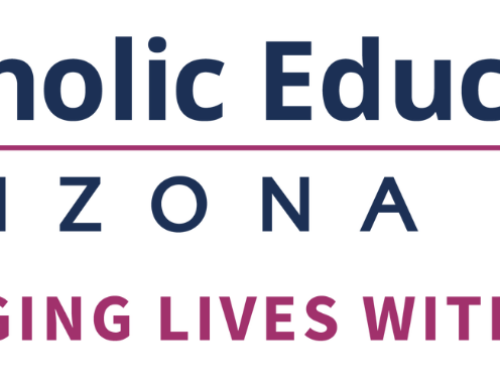By Nancy Padberg, MBA, President and CEO of Catholic Education Arizona
Being a CEO is more than setting an organization’s direction—it’s about creating personal and professional habits that inspire success. I believe that the following habits lay the foundation for effectively building a healthy culture, creating sustainable growth and driving meaningful change.
1. Strategic Thinking
Successful CEOs develop a compelling vision for their organization and chart a strategic path to achieve it. This vision may constantly be refined and reworked based on industry trends and stakeholder needs.
Revisit your strategic plan annually. Given the economy’s ever-changing landscape, political factors, and legislative shifts, it’s essential to ask: Is this strategic plan on track? Does it need adjustments?
See if you can reassess your plan at least annually, and consider conducting a SWOT analysis to help identify and assess new opportunities or threats. A SWOT analysis helps you identify strengths, weaknesses, opportunities and threats.
2. Decisiveness
Decisiveness fuels momentum, building the team’s confidence and pushing initiatives forward. This is why confidence and clarity in decision-making are crucial for CEOs. Here are a couple of guidelines I have in place to help me make decisions quickly and confidently.
- Build trust with subject matter experts (SMEs). Trusting your sources allows you to confidently take the best step forward in areas you may not be well-versed in. As the CEO of a nonprofit, Catholic Education Arizona, I hire SMEs for significant roles. For example, our COO is an expert in our Diocese of Phoenix and our schools, while our VP of finance and compliance is an expert in compliance because she worked for the Arizona Department of Revenue, working in Arizona tax credits. Also, when we launched a donations division, we hired an expert in planned gifts and development to ensure that we were building our division on the right foundation.
- Establish transparent processes to streamline decisions. For example, if I need to make a quick decision, I can contact Board Members, my executive team, or my business coach for immediate feedback.
3. Effective Communication
Clear and consistent communication is a cornerstone of leadership. Associates should not be left guessing or overthinking, which is why effective communication is not just about having regular meetings but choosing the right method of communication for each situation.
Match the communication method to the message’s urgency. For example, I’ve found that email works for longer, less time-sensitive updates (24-hour response window), texts are better for quicker or more urgent matters (1-hour response window) and phone calls are best for immediate or time-sensitive issues. I also recommend putting consistent one-on-one meetings on the calendar for collaboration and project updates.
Ensure your team understands how and when to use each communication channel. This can keep operations running smoothly and transparently.
4. Adaptability and Resilience
The ability to shift course while keeping stakeholders’ needs in mind keeps an organization agile and effective. Building strong relationships with stakeholders ensures open feedback. This feedback often informs how we adapt as leaders or as an organization as a whole, whether it’s responding to legislative changes and needing to create an entirely new fundraising division or rethinking hybrid work models to meet the team’s needs.
5. Focus on Team Building
Everyone brings a set of unique gifts, and addressing these strengths helps the team understand one another better, leading to an appreciation for one another. Here are a few tools that I’ve used with my team to strengthen our team and help us understand each other:
- Gallup CliftonStrengths assesment is an excellent tool for defining each associate’s unique talents and characteristics. This helps us better understand each associate.
- The 6 Working Geniuses by Patrick Lencioni addresses each associate’s natural work style by focusing on their unique strengths and areas of weakness.
6. Continuous Learning
Leadership requires a commitment to lifelong learning. I earned my MBA at Pepperdine University’s Graziadio School of Business in 2003, but my education didn’t stop there. Continuous learning drives leaders to ask better questions and make better decisions.
I’ve found CEO Coaching and hiring a business coach to be invaluable to my continuous learning path, reinforcing that if you’re not learning and evolving, you’re moving backward. I’ve spent three years with Vistage, the world’s largest CEO coaching and peer-advisory organization. It provides ongoing learning and a collaborative environment. I recommend reading or listening to books. I invest 30 minutes each morning to learn about leadership. Investing in leadership growth will strengthen your skills and, ultimately, your organization.
7. Proper Time and Energy Management
Managing time and energy is about discipline. Just as a good night’s sleep prepares you for a productive day, taking purposeful breaks prevents burnout and sharpens focus. Here are some ways I’ve found helpful for managing my time and energy:
- Prioritize tasks: Try making a list of your to-dos and order them from highest priority to lowest. Choose to accomplish your top priorities today, and know there will be time throughout the next week to complete the list.
- Delegate responsibilities: When you have a team of associates you trust, you know there are others you can count on to get the job done.
- Maintain personal well-being: Burnout only makes it more challenging to complete tasks. Take moments throughout the day to take a break, a breath, or a quick walk. Getting outside or doing breathing exercises at your desk will help you refocus on your task.
While these seven habits support successful leadership, remember that not all come naturally. As a leader or aspiring CEO, I encourage you to reflect on your strengths and weaknesses and commit to strengthening your weaknesses. With focus and dedication, you’ll create a framework to inspire your team, build a healthier culture, and drive lasting impact.




